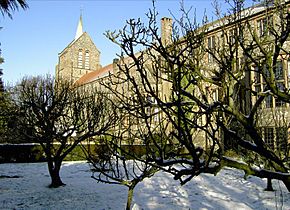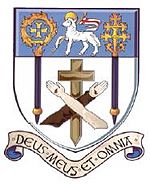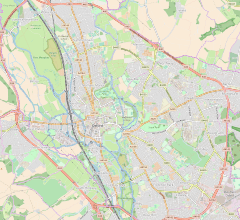Greyfriars, Oxford facts for kids
Quick facts for kids Greyfriars |
|||||||||||||||||||||||||||||||||
|---|---|---|---|---|---|---|---|---|---|---|---|---|---|---|---|---|---|---|---|---|---|---|---|---|---|---|---|---|---|---|---|---|---|
 |
|||||||||||||||||||||||||||||||||
 |
|||||||||||||||||||||||||||||||||
|
|
|||||||||||||||||||||||||||||||||
| University | University of Oxford | ||||||||||||||||||||||||||||||||
| Location | Iffley Road | ||||||||||||||||||||||||||||||||
| Coordinates | 51°44′48″N 1°14′25″W / 51.746801°N 1.240168°W | ||||||||||||||||||||||||||||||||
| Motto | My God and My All | ||||||||||||||||||||||||||||||||
| Established | 1910 | ||||||||||||||||||||||||||||||||
| Closed | 2008 | ||||||||||||||||||||||||||||||||
| Named for | The Order of Friars Minor Capuchin | ||||||||||||||||||||||||||||||||
| Previous names | Grosseteste House (1919–1930) | ||||||||||||||||||||||||||||||||
| Warden | Mark Elvins | ||||||||||||||||||||||||||||||||
| Undergraduates | c. 50 (2008) | ||||||||||||||||||||||||||||||||
| Map | |||||||||||||||||||||||||||||||||
Greyfriars was a special kind of college at the University of Oxford until 2008. It was also a Roman Catholic friary (a home for friars, who are like monks but live and work more in the community). It was located in East Oxford, on Iffley Road.
Greyfriars was one of the smallest parts of the university. It was called a "permanent private hall" (PPH). This meant it was run by an outside group, the Order of Friars Minor Capuchin (a type of Franciscan religious order), not by the university itself.
In 2007, the leaders decided to close the college part of Greyfriars. The students were moved to Regent's Park College. The buildings are still used as a friary today.
Greyfriars has a very unique building in Oxford. It is the only building in the city made of flint-stone in the Norman style. Its green spire (a tall, pointed roof) can be easily seen from Iffley Road and the university's running track.
Contents
Greyfriars: A Look Back
Early Beginnings: The Medieval Friary
The first Greyfriars church and friary were started by the Franciscans in 1224. These friars had a long and respected history in Oxford. Many famous people studied there. One important person was Robert Grosseteste. He was an English leader and a religious scholar. He became the head of Greyfriars and later the first leader of the University of Oxford.
Around 1517, the Franciscan order split into different groups. The friaries were later closed down during the English Reformation in the 1500s. This was a time when the King of England changed the country's religion.
The Friary and College in the 20th Century
In 1905, a group called the Capuchin Franciscans started a new friary. It was called St Anselm's. The university recognized it as a place for studies in 1910. A church, St Edmund and St Frideswide, was built nearby in 1911.
In 1928, the Capuchins took over this church. They then built the friary we see today. In 1919, the friars moved to the current location on Iffley Road. They first named it Grosseteste House, after Robert Grosseteste. Once the main building was finished in 1930, they changed the name back to Greyfriars. The university officially made Greyfriars a "permanent private hall" in 1957.
In 2007, Greyfriars celebrated 50 years of being a PPH. It was a special year, and many students earned top grades.
Why Greyfriars Hall Closed
In October 2007, the Capuchin order announced they would stop running Greyfriars as a university hall. This was due to money problems and not enough friars to help. The building was old, and it cost too much to keep it up and pay staff. This would have affected their other important work.
All students were moved to Regent's Park College. This decision caused some debate. The university decided that no other group could take over Greyfriars as a PPH. So, the hall closed in June 2008. Even the Holy See (the main leadership of the Catholic Church) tried to save it at the last minute.
It might seem strange that Greyfriars students didn't go to other Catholic colleges. But Greyfriars had started accepting female students earlier. The other Catholic colleges had not done so at that time. Regent's Park College welcomed the students. A special plaque there remembers this move. Regent's Park College even started a scholarship in Greyfriars' name in 2018.
The Capuchin Order still lives at Greyfriars in Oxford. The buildings are still used as a friary, and they continue to look after the local church.
Life at Greyfriars
Friary and Learning
Greyfriars was special because its university hall and Franciscan friary were in the same place. The friars and students lived side-by-side. They often ate meals together. Students did not have to be religious to apply.
While Greyfriars was known for its religious scholars, students studied many different subjects. These included English, history, theology (the study of religion), geography, and law. The hall had some tutors, but students usually went to other Oxford colleges for most of their lessons. Balliol College was a close partner, especially for sports.
Student Life and Activities
Even though Greyfriars was small, it had a close and active student community. In the late 1990s and early 2000s, there were usually about 30 undergraduate students. By 2003, the number grew to around 50 students when it closed.
The hall held a popular summer garden party each year. They also had a fun dance party called 'The Monastery of Sound'. Greyfriars students were very involved in university life. They joined groups like the Oxford Law Society, the Conservative Association, and the Dramatic Society. They also played sports like rowing, hockey, rugby, tennis, and table tennis. Their involvement was much bigger than their small numbers suggested.
Like all Oxford colleges, Greyfriars had a student committee called the JCR. Students elected a president, secretary, treasurer, and other officers each year to run student activities.
Famous People from Greyfriars' Past
Many important people studied at the original Greyfriars. Here are a few:
- Robert Grosseteste (around 1175–1253)
- Roger Bacon, a famous scientist (around 1214–1292)
- John Duns Scotus, a well-known philosopher (around 1264–1309)
- William of Occam, another famous philosopher (around 1300–1394)
Greyfriars Society
The Greyfriars Society was started in 1999. It is the official group for former students of Greyfriars. Its main goals are to keep in touch with alumni (former students) and to raise money. This money helped Greyfriars provide the best education for its students. The current President is David Alton.


